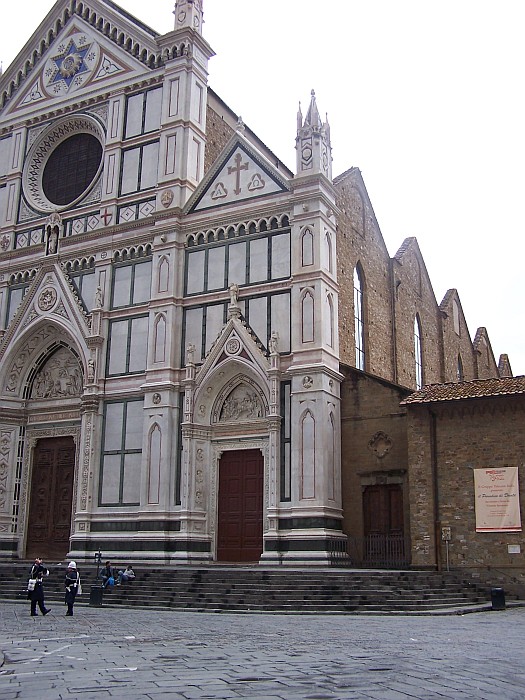

With its impressive gothic architecture, marvellous frescoes, altar pieces, precious stained-glass windows and numerous sculptures, the Basilica represents one of the most important pages in the history of Florentine art from the thirteenth century onwards. The indisputable fascination that this place exerts, in an unequalled synthesis of art, spirituality and history, is confirmed by the influx of around one million visitors a year.

The Arnolfo and Brunelleschi Cloisters provide visitors with fine examples of Renaissance architectural precision, and a moment of peace and tranquility during their tour. The rest of the monastic buildings ranged around the cloister form a museum of religious painting and sculpture.
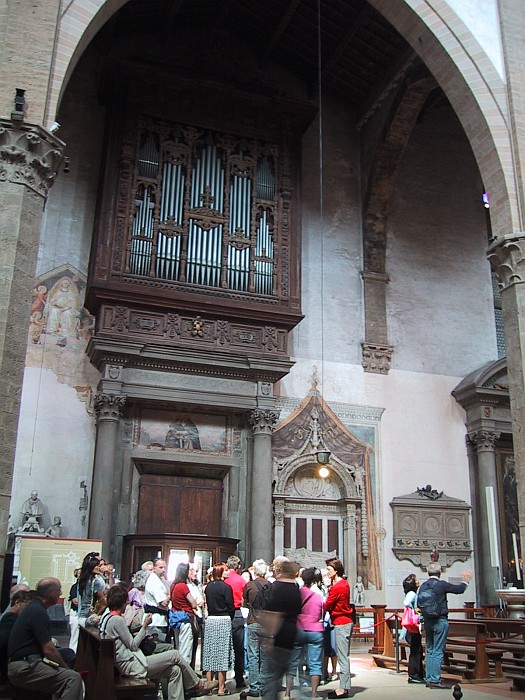
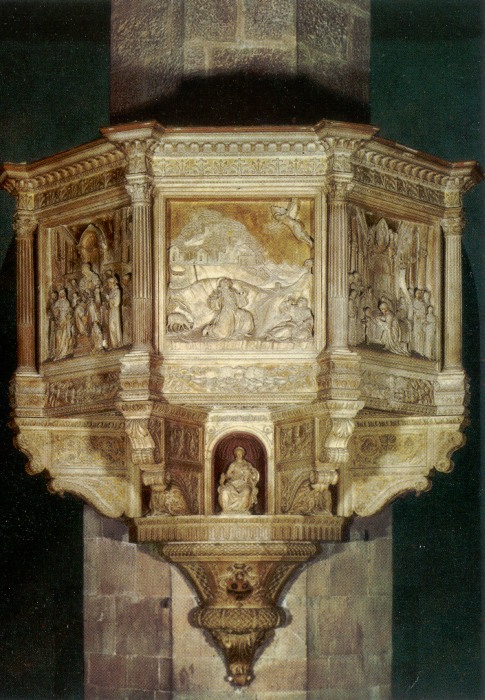
Pulpit by Benedetto da Maiano
Excerpt from Thomas Harris, Hannibal
The Church of Santa Croce, seat of the Franciscans, its vast interior ringing with eight languages as the hordes of tourists shuffle through, following the bright umbrellas of their guides, fumbling for two-hundred lire pieces in the gloom so they can pay to light, for a precious minute in their lives, the great frescoes in the chapels. [Since a fee is now charged to enter the church, the frescoes are continuously luminated.]
Romula came in from the bright morning and had to pause near the tomb of Michelangelo while her dazzled eyes adjusted. When she could see that she was standing on a grave in the floor, she whispered, “Mi dispiace!” and moved quickly off the slab; to Romula the throng of dead beneath the floor was as real as the people above it, and perhaps more influential. She was daughter and granddaughter of spirit readers and palmists, and she saw the people above the floor, and the people below, as two crowds with the mortal pane between. The ones below, being smarter and older, had the advantage in her opinion.
She looked around for the sexton, a man deeply prejudiced against Gypsies, and took refuge at the first pillar under the protection of Rossellino’s “Madonna del Latte,” while the baby nuzzled at her breast. Pazzi, lurking near Galileo’s grave, found her there.
He pointed with his chin toward the back of the church where, across the transept, floodlights and forbidden camera flashed like lightning through the vast high gloom as the clicking timers ate two-hundred-lire pieces and the occasional slug or Australian quarter.
Again and again Christ was born, betrayed, and the nails driven as the great frescoes appeared in brilliant light, and plunged again into a darkness close and crowded, the milling pilgrims holding guidebooks they cannot see, body odor and incense rising to cook in the heat of the lamps.
In the left transept, Dr. Fell was at work in the Capponi Chapel. The Glorious Capponi Chapel is in Santa Felicità. This one, redone in the nineteenth century, interested Dr. Fell because he could look through the restoration into the past. He was making a charcoal rubbing of an inscription in stone so worn that even oblique lightning would not bring it up. . . .
A bell, and it was time for the midday closing. Sextons came out, rattling their keys, ready to empty the coin boxes. [Now there is no noon closing.]
Dr. Fell rose from his labors and came out from behind Andreotti’s Pietà in the chapel.
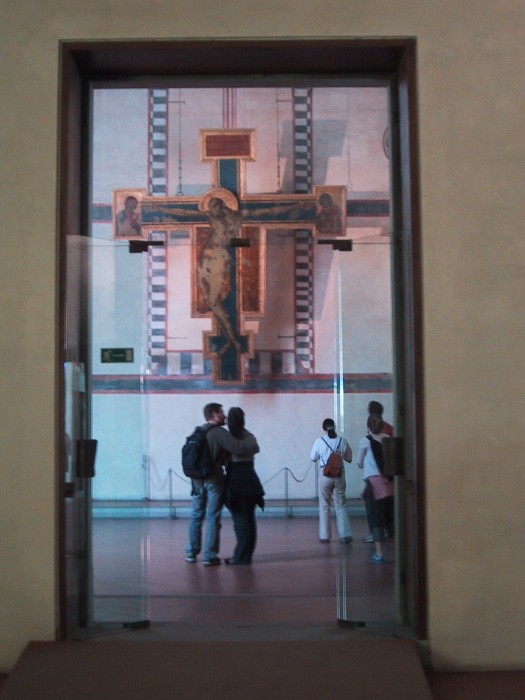
The flood-ruined 13th century masterpiece, the Crucifixion,
still expresses the grandeur of Cimabue's artistry.
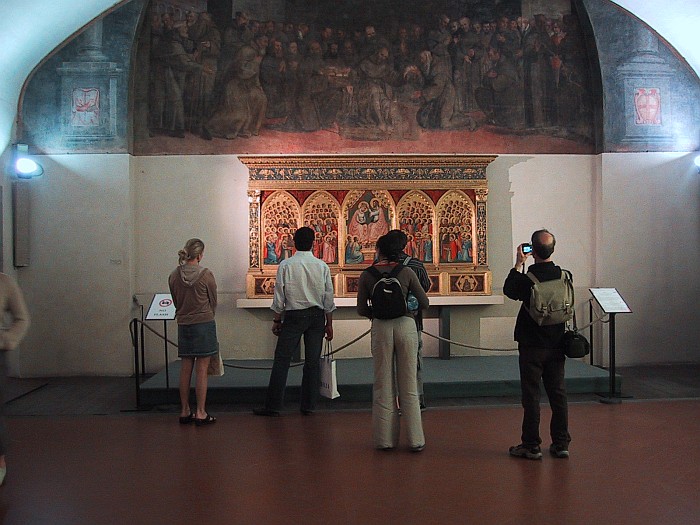
Baroncelli Polyptych by Giotto and assistants, Baroncelli Chapel
Santa Croce houses works of art by Cimabue, Giotto, Filippo Brunelleschi, Donatello, Giorgio Vasari, Lorenzo Ghiberti, Orcagna, Taddeo and Agnolo Gaddi, Della Robbia, Giovanni da Milano, Bronzino, Michelozzo, Domenico Veneziano, Maso di Banco, Giuliano da Sangallo, Benedetto da Maiano, Canova and many others. In particular, the presence of Giotto and his school of art makes Santa Croce an extraordinarily complete testimony of Fourteenth Century Florentine art.
Marriage of the Virgin by Taddeo Gaddi
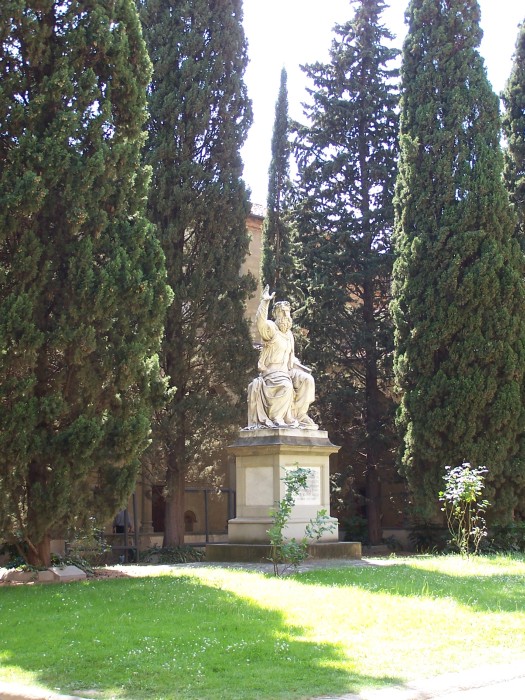
God the Father, Baccio Bandinelli - Small Cloister